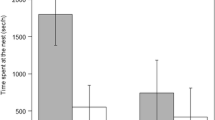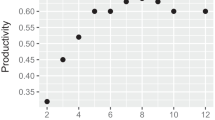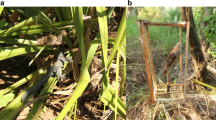Abstract
Reproductive adults in many bird species are assisted by non-breeding auxiliary helpers at the nest, yet the impact of auxiliaries on reproduction is variable and not always obvious. In this study, we tested Hamilton’s rule and evaluated the effect of auxiliaries on productivity in the facultative cooperative breeder campo flicker (Colaptes campestris campestris). Campo flickers have a variable mating system, with some groups having auxiliaries and others lacking them (i.e., unassisted pairs). Most auxiliaries are closely related to the breeding pair (primary auxiliaries), but some auxiliaries (secondary auxiliaries) are unrelated females that joined established groups. We found no effect of breeder quality (body condition) or territory quality (food availability) on group productivity, but the presence of auxiliaries increased the number of fledglings produced relative to unassisted pairs. Nonetheless, the indirect benefit of helping was small and did not outweigh the costs of delayed breeding and so seemed insufficient to explain the evolution of cooperative breeding in campo flickers. We concluded that some ecological constraints must limit dispersal or independent breeding, making staying in the group a “best-of-a-bad-job” situation for auxiliaries.



Similar content being viewed by others
References
Brand N, Chapuisat M (2014) Impact of helpers on colony productivity in a primitively eusocial bee. Behav Ecol Sociobiol 68:291–298
Brouwer L, Heg D, Taborsky M (2005) Experimental evidence for helper effects in a cooperatively breeding cichlid. Behav Ecol 16:667–673
Brouwer L, Richardson DS, Komdeur J (2012) Helpers at the nest improve late-life offspring performance: evidence from a long-term study and a cross-foster experiment. PLoS One 7, e33167
Brown JL, Dow DD, Brown ER, Brown SD (1978) Effects of helpers on feeding of nestlings in the grey-crowned babbler (Pomatostomus temporalis). Behav Ecol Sociobiol 13:115–124
Brown JL (1987) Helping and communal breeding in birds. Princeton University Press, Princeton
Bruintjes R, Heg-Bachar Z, Heg D (2013) Subordinate removal affects parental investment, but not offspring survival in a cooperative cichlid. Funct Ecol 27:730–738
Caffrey C (2000) Correlates of reproductive success in cooperatively breeding western American crows: if helpers help, it’s not by much. Condor 102:333–341
Canário F, Matos S, Soler M (2004) Environmental constraints and cooperative breeding in the azure-winged magpie. Condor 106:608–617
Canestrari D, Marcos JM, Baglione V (2008) Reproductive success increases with group size in cooperative carrion crows, Corvus corone corone. Anim Behav 75:403–416
Carlisle TR, Zahavi A (1986) Helping at the nest, allofeeding and social status in immature Arabian babblers. Behav Ecol Sociobiol 18:339–351
Clutton-Brock TH (2002) Breeding together: kin selection and mutualism in cooperative vertebrates. Science 296:69–72
Cockburn A (1998) Evolution of helping behaviour in cooperatively breeding birds. Annu Rev Ecol Syst 29:141–177
Cockburn A, Sims RA, Osmond HJ, Green DJ, Double MC, Mulder RA (2008) Can we measure the benefits of help in cooperatively breeding birds: the case of superb fairy-wrens Malurus cyaneus? J Anim Ecol 77:430–438
Conner RN, Saenz D, Schaefer RR, McCormick JR, Rudolph DC, Burt DB (2004) Group size and nest success in red-cockaded woodpeckers in west gulf coastal plain: helpers make a difference. J Field Ornithol 75:74–78
Dias RI, Webster MS, Goedert D, Macedo RH (2013a) Cooperative breeding in the campo flicker I: breeding ecology and social behavior. Condor 115:847–854
Dias RI, Macedo RH, Goedert D, Webster MS (2013b) Cooperative breeding in the campo flicker II: patterns of reproduction and kinship. Condor 115:855–862
Dickinson JL, Koenig WD, Pitelka FA (1996) Fitness consequences of helping behavior in the western bluebird. Behav Ecol 7:168–177
Dickinson J, Hatchwell BJ (2004) Fitness consequences of helping. In: Koenig WD, Dickinson JL (eds) Ecology and evolution of cooperative breeding in birds. Cambridge University Press, Cambridge, pp 48–66
Doerr ED, Doerr VA (2007) Positive effects of helpers on reproductive success in the brown treecreeper and the general importance of future benefits. J Anim Ecol 76:966–976
Dunn PO, Cockburn A, Mulder RA (1995) Fairy-wren helpers often care for young to which they are unrelated. Proc R Soc Lond B Bio 259:339–343
Du-Plessis MA, Siegfried WR, Armstrong AJ (1995) Ecological and life-history correlates of co-operative breeding in South African birds. Oecologia 102:180–188
Eguchi K, Yamagishi S, Asai S, Nagata H, Hinos T (2002) Helping does not enhance reproductive success of cooperatively breeding Rufous vanga in Madagascar. J Anim Ecol 71:123–130
Ekman J, Dickinson L, Hatchwell J, Griesser M (2004) Delayed dispersal. In: Koenig WD, Dickinson JL (eds) Ecology and evolution of cooperative breeding in birds. Cambridge University Press, Cambridge, pp 35–47
Emlen ST (1982) The evolution of helping I. An ecological constraints model. Am Nat 119:29–39
Emlen ST (1991) The evolution of cooperative breeding in birds and mammals. In: Krebs J, Davies N (eds) Behavioural ecology, 3rd edn. Blackwell Scientific Publications, Oxford
Emlen ST, Wrege PH (1991) Breeding biology of white-fronted bee-eaters at Nakuru—the influence of helpers on breeder fitness. J Anim Ecol 60:309–326
Gaston AJ (1978) The evolution of group territorial behavior and cooperative breeding. Am Nat 112:1091–1100
Hamilton WD (1964) The genetical theory of social behavior. I and II. J Theor Biol 7:1–52
Hardy OJ, Vekemans X (2002) SPAGeDi: a versatile computer program to analyse spatial genetic structure at the individual or population levels. Mol Ecol Notes 2:618–620
Hatchwell BJ (1999) Investment strategies of breeders in avian cooperative breeding systems. Am Nat 154:205–219
Hatchwell BJ, Russell AF (1996) Provisioning rules in cooperatively breeding long-tailed tits. Proc Royal Soc B 263:83–88
Hatchwell BJ, Russell AF, MacColl ADC, Ross DJ, Fowlie MK, McGowan A (2004) Helpers increase long-term but not short-term productivity in cooperative breeding long-tailed tits. Behav Ecol 15:1–10
Hatchwell BJ (2009) The evolution of cooperative breeding in birds: kinship, dispersal and life history. Philos T R Soc B 364:3217–3227
Heinsohn RG, Cockburn A, Cunningham RB (1988) Foraging, delayed maturity and cooperative breeding in white-winged choughs (Corcorax melanorhamphos). Ethology 77:177–186
Heinsohn RG (1992) Cooperative enhancement of reproductive success in white-winged choughs. Evol Ecol 6:97–114
Khan MZ, Walters JR (1997) Is helping a beneficial learning experience for red-cockaded woodpecker (Picoides borealis) helpers? Behav Ecol Sociobiol 41:69–73
Kalinowski ST, Taper ML, Marshall TC (2007) Revising how the computer program CERVUS accommodates genotyping error increases success in paternity assignment. Mol Ecol 16:1099–1106
Kokko H, Johnstone RA, Clutton-Brock TH (2001) The evolution of cooperative breeding through group augmentation. Proc R Soc Lond B Bio 268:187–196
Kokko H, Johnstone RA, Wright J (2002) The evolution of parental and alloparental care in cooperatively breeding groups: when should helpers pay to stay? Behav Ecol 13:291–300
Komdeur J (1996) Influence of helping and breeding experience on reproductive performance in the Seychelles warbler: a translocation experiment. Behav Ecol 7:326–333
Legge S (2000) The effect of helpers on reproductive success in laughing kookaburra. J Anim Ecol 69:714–724
Ligon JD, Ligon SH (1978) Communal breeding in green woodhoopoes as a case for reciprocity. Nature 276:496–498
Lucas JR, Creel SR, Waser PM (1996) How to measure inclusive fitness, revisited. Anim Behav 51:225–228
Manica LT, Marini MA (2012) Helpers at the nest of white-banded tanager Neothraupis fasciata benefit male breeders but do not increase reproductive success. J Ornithol 153:149–159
Marshall TC, Slate J, Kruuk LEB, Pemberton JM (1998) Statistical confidence for likelihood-based paternity inference in natural populations. Mol Ecol 7:639–655
McGowan A, Hatchwell BJ, Woodburn RJW (2003) The effect of helping behaviour on the survival of juvenile and adult long-tailed tits Aegithalos caudatus. J Anim Ecol 72:491–499
Mulder RA, Langmore NE (1993) Dominant males punish helpers for temporary defection in superb fairy-wrens. Anim Behav 45:830–833
Mumme RL (1992) Do helpers increase reproductive success? An experimental analysis in the Florida scrub jay. Behav Ecol Sociobiol 31:319–328
Pinheiro F, Diniz IR, Coelho D, Bandeira MPS (2002) Seasonal pattern of insect abundance in the Brazilian Cerrado. Austral Ecol 27:132–136
Powell RA, Fried JJ (1992) Helping by juvenile pine voles (Microtus pinetorum), growth and survival of younger siblings, and the evolution of pine vole sociality. Behav Ecol 3:325–333
Pruett-Jones S (2004) Summary. In: Koenig WD, Dickinson JL (eds) Ecology and evolution of cooperative breeding in birds. Cambridge University Press, Cambridge, pp 228–238
Queller DC, Goodnight K (1989) Estimating relatedness using genetic markers. Evolution 43:258–275
R Development Core Team (2014): R: a language and environment for statistical computing. R Foundation for Statistical Computing, Vienna, Austria. ISBN 3-900051-07-0, URL (http://www.R-project.org)
Reyer HU (1984) Investment and relatedness: a cost/benefit analysis of breeding and helping in the pied kingfisher (Ceryle rudis). Anim Behav 32:1163–1178
Russell AF, Langmore NE, Cockburn A, Astheimer LB, Kilner RM (2007) Reduced egg investment can conceal helper effects in cooperatively breeding birds. Science 317:941–944
Short LL (1972) Systematics and behavior of South American flickers (Aves: Colaptes). B Am Mus Nat Hist 149:1–110
Stacey PB, Koenig WD (1990) Cooperative breeding in birds: long-term studies of ecology and behavior. Cambridge University Press, Cambridge
Woxvold IA, Magrath MJL (2005) Helping enhances multiple components of reproductive success in the cooperatively breeding apostlebird. J Anim Ecol 74:1039–1050
Acknowledgments
We thank the Conselho Nacional de Desenvolvimento Científico e Tecnológico for support through student scholarships to R.I.D. and a fellowship to R.H.M. We thank the François Vuilleumier Fund and the University of Brasília for financial support. We thank Débora Goedert, João V. Caetano, and Paula Sicsú for help with fieldwork. We thank Irby Lovette for allowing access to his lab and especially Laura Stenzler for all the support during lab work.
Compliance with ethical standards
The study complied with the current laws of Brazil under permits 14368 and 2056 from Instituto Brasileiro de Recursos Renováveis.
Conflict of interest
The authors declare that they have no conflict of interest.
Author information
Authors and Affiliations
Corresponding author
Additional information
Communicated by: Sven Thatje
Rights and permissions
About this article
Cite this article
Dias, R.I., Webster, M.S. & Macedo, R.H. Helping enhances productivity in campo flicker (Colaptes campestris) cooperative groups. Sci Nat 102, 31 (2015). https://doi.org/10.1007/s00114-015-1281-8
Received:
Revised:
Accepted:
Published:
DOI: https://doi.org/10.1007/s00114-015-1281-8




